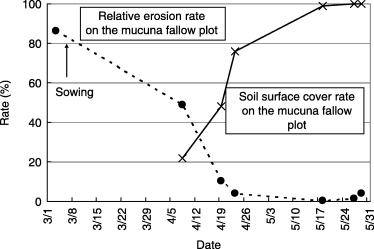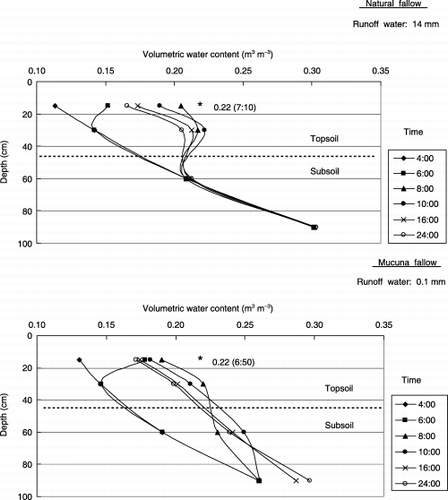Abstract
This study was conducted on a sloping field at the Japan International Research Center for Agricultural Sciences, Okinawa Subtropical Station, Ishigaki Island, Okinawa Prefecture, Japan, to evaluate the effects of zero tillage farming combined with mucuna fallow as a cover crop on soil erosion and water dynamics. Two fallow systems (natural and mucuna) in combination with two soil tillage treatments (zero tillage and conventional tillage) were imposed on three sloping fields (2.0°, 3.5° and 5.0°). A sorghum crop (Sorghum bicolor (L) moench) was planted after the soil tillage treatment. Soil loss for zero tillage farming combined with mucuna fallow was equivalent to only 3% of that for the conventional tillage farming with natural fallow. Runoff water was also reduced by between 74% and 77% when compared with the conventional tillage system with natural fallow. These results indicate that zero tillage with mucuna fallow is a very effective measure for the control of soil erosion and water runoff. Moreover, this farming system improved water infiltration during both the fallow and the sorghum cropping periods. For the zero tillage plot, water loss as deep percolation increased 1.6-fold compared with that for the conventional farming under heavy rainfall conditions. It is expected that under less rainfall areas or seasons, the effects of zero tillage farming combined with the mucuna cover crop may be more pronounced on water runoff control and, therefore, may greatly improve soil water conditions.
INTRODUCTION
Research on zero tillage farming began in the USA during the 1940s for the purpose of soil conservation. Today, 19 million hectares are under zero tillage: a figure that represents 16% of the total cultivated land area (CitationDerpsch 1998). The techniques of zero tillage were subsequently transferred to South America, and in countries such as Brazil and Paraguay zero tillage farming currently covers 21% and 52% of the cultivated land, respectively (CitationFood and Agriculture Organization 2001). Weeding, one of the most important problems tackled by zero tillage farming, is generally controlled by herbicides, and the development of various effective herbicides contributed to the expansion of zero tillage farming system (CitationGazziero 1998). Zero tillage farming without the use of herbicides, however, remains difficult, and this probably limits its adoption by poor farmers in Africa (CitationKyuma 2001). Meanwhile, green manure has long been used to improve soil fertility. In addition, there is a growing interest in the use of green manure for the control of for example, soil erosion, weeds and nematodes. Today, “green manure cover crop” is one of the world's important research issues (CitationCavigelli and Thien 2003; CitationGriffin et al. 2000; CitationMartens et al. 2001).
The two farming systems of green manure and zero tillage have gradually been combined. Incorporating cover crops or major crops into zero tillage farming systems has been a focus of several research programs, for example, crop rotation to reduce the use of herbicides and other agrochemicals (CitationGazziero 1998). It is believed that zero tillage farming combined with cover crops may result in multiple effects in addition to weed control, such as reducing water runoff and soil erosion and improving soil fertility.
Mucuna bean (Mucuna pruriens (L.) DC) was used as a cover crop in this study because it is commonly grown in African and South American countries. Its vigorous growth enables it to smother weeds and protect soil surfaces. In addition, through atmospheric nitrogen
Table 1 Physical characteristics of the soils of the sloping plots
MATERIALS AND METHODS
Study site
The present study was conducted in 2004 on 18 newly developed sloping plots located at the Japan International Research Center for Agricultural Sciences (JIRCAS) Subtropical Station on Ishigaki Island, Okinawa Prefecture, Japan. After removing the topsoil, sloping fields of 2°, 3.5° and 5° were formed with originally located subsoil. The topsoil was then packed to a depth of 45 cm. Each sloping field was separated by plastic wave plates to delimit six plots (14 m long, 4.2 m wide). The original soil, locally called Kunigami mahji, is classified as a red soil in the Japanese soil classification system (CitationNational Institute of Agro-Environmental Science 1996); this corresponds to an Ultisol in the USDA soil taxonomy (CitationHamazaki 2005). This soil is characterized by a fragile structure and a high susceptibility to crusting (CitationMiyara et al 1999); it is, therefore, susceptible to soil erosion. After packing the soil in July 2003, the field was cultivated once and then left undisturbed until the study began in March 2004. At the beginning of the experiment, a soil survey was conducted at the outside of the plots on the 2° and 5° sloping fields where the water dynamics of the soil was monitored (one pit at each sloping field). Undisturbed soil samples with 100 mL cores were also taken at 15, 30, 60 and 90 cm soil depth for physical analysis. shows the physical properties of the soils. The saturated conductivity of the soil was high, generally ranging from 10−2 to 10−3 cm s−1, probably because of weak compaction during the packing. The bulk density ranged from 1.26 to 1.62 Mg m−3. The subsoil layer at depths of 60 and 90 cm on the 2° slope, in particular, was characterized by a low bulk density and a very high saturated hydraulic conductivity because of subsoil disturbance during the slope formation. A ground water table was not found (down to a depth of 105 cm).
Experimental design and agronomic practices
The fallow period extended from 8 March until 31 May 2004, followed by sorghum cropping from 1 June until 22 September 2004. shows the experimental design. Prior to the fallow period, a herbicide (gliphosate) was applied to all plots to eradicate the existent weeds. Thereafter, mucuna was sown with a spacing of 40 cm × 20 cm in three plots for the mucuna fallow (m), while the remaining plots were untreated (natural fallow: n). On 1 and 2 June, tillage treatment (T) for the subsequent sorghum cropping was conducted to a depth of 15 cm using a hand tractor after slashing the mucuna plants. In the case of the natural fallow, tillage did not require slashing for incorporation. In the zero tillage treatment (Z) after the mucuna fallow, slashed plant material remained on the soil surface as mulch without incorporation. For the zero tillage treatment (Z) after the natural fallow, the fallow plants were eradicated by herbicide (gliphosate). Sorghum was sown with a spacing of 70 cm × 30 cm immediately after tillage treatment. Chemical fertilizers were applied at three levels: the recommended amount (1F) after natural fallow; half the recommended level (1/2F) after mucuna fallow; and no application
Table 2 Experimental design
Monitoring of soil surface cover rates by green biomass
Overhead photographs were taken periodically at approximately 3.5 m above the ground surface using a digital camera fixed to the tip of a 4-m-long stick to monitor the relationship between soil surface cover rates by plants and soil erosion rate. The color of the green vegetated area in the images was modified to distinguish it from the background, and the image was then binarized using an image-processing program (Adobe Photoshop version 5.0, Adobe Systems San Jose, USA). The soil cover rate was measured using a histogram tool in the same program.
Soil erosion and water runoff measurement
At the lowest edge of each plot, a container was installed to collect sedimented soil particles during each rain event to determine soil loss. Sediments were collected and then weighed after drying in an oven at 70°C. Water runoff was determined by measuring overflowing water from the soil sedimentation container through a V-type weir in which the water level was monitored at 1 min intervals by an echo sensor (UIZ-ECH20, UIZIN Tokyo, Japan), a device used for soil water measurement.
Monitoring of soil water content
Time domain reflectometers (TDR, CS 616, Campbell Scientific, North Logan, USA) were installed horizontally at depths of 15, 30, 60 and 90 cm in the middle slope of the mT-1/2F, mZ-1/2F and nT-1F on the 2° and 5° sloping plots. Soil volumetric water content was recorded at 10 min intervals. The sensors installed at depths of 15 and 30 cm were calibrated with soil samples taken from the field. Those installed at depths of 60 and 90 cm were calibrated using an experimental equation distributed by the manufacturer because no field calibration has been done because of small changes in water content in deeper soil layers. The data for the manual calibration showed a good fit with the calibration curve provided by the manufacturer with a difference of approximately 2–3%.
Water balance calculation during and after particular rain events
The water balance equation during a rain event is expressed as follows:
where P is the total precipitation during a continuous rain event, ΔS is the change in stored water for a 105 cm thick layer (considered as the lower limit of the root zone), R is runoff water, D is deep percolation below a depth of 105 cm, and ET is the evapotranspiration during a given period. In this study, ET was ignored because of its relatively low importance compared with the amount of rainfall over short periods of time. Therefore, the modified water balance equation (Equation1) is as follows:
In Equation (Equation2), ΔS was calculated from soil water contents in successive soil layers: 0–15 cm, 15–30 cm, 30–60 cm and 60–90 cm at 1 h intervals. The water contents were measured by TDR sensors installed at the bottom of each layer (15, 30, 60 and 90 cm in soil depth, respectively). R was calculated from the water discharge, which was measured by the V-type weir, divided by the total area of the plot (58.8 m2). The water balance was determined at 00:00 am on a day with a large amount of rainfall and 2 days after the end of the rain event. The 2-day interval has been determined as the time required for the soil water content to reach field capacity after a rain event (CitationHasegawa 1999).
RESULTS
Climatic conditions during the cropping period
shows the daily rainfall record and the maximum and minimum air temperatures for March to September 2004. The cropping period was characterized by the frequent occurrence of typhoons accompanied by heavy rainfall. Soil erosion was observed six times during the fallow period and five times during the sorghum cropping period. Air temperature gradually increased from March to May, and the maximum temperature remained higher than 30°C until the end of September.
Effect of fallow treatment combined with tillage practice on soil erosion
shows the total soil loss for the different treatments during the fallow and sorghum cropping periods. Soil erosion increased with increasing slope for all treatments. Important differences were observed between treatments. Indeed, soil erosion for the nT, which is
Figure 1 Climatic conditions and cropping calendar. Total rainfall during March and August was 1233 mm. Rain events marked with an asterisk show the occurrence of soil erosion.
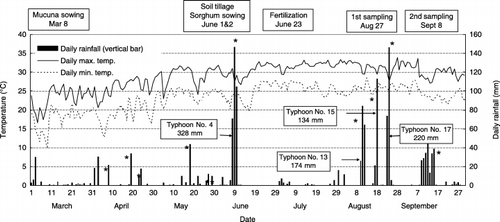
Figure 2 Total soil erosion rate during the cropping season for different treatments. m, mucuna fallow; n, natural fallow; T, tillage treatment; Z, zero tillage treatment; 0F, no fertilizer; 1/2F, half the recommended fertilizer level; 1F, recommended fertilizer level.
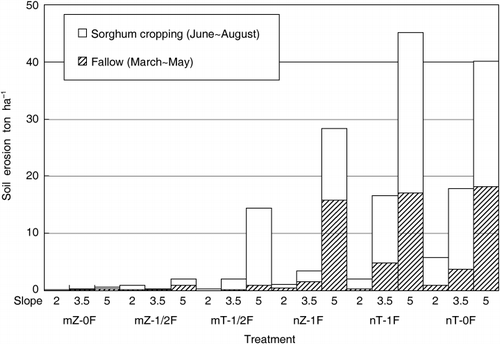
During the fallow period, the nZ-1F, the nT-1F and the nT-0F were all natural fallow, while the mT-1/2F, the mZ-1/2F and the mZ-0F were mucuna fallow. The total soil loss for the natural fallow was 17 ton ha−1 (average of the nZ-1F, the nT-1F and the nT-0F) for the 5° sloping plots, while that for the mucuna fallow was 0.8 ton ha−1, equivalent to 4.7% of that for the natural fallow. During the sorghum cropping period, the total soil loss for the mZ treatment was maintained at a low rate (0.68 ton ha−1 as an average of the mZ-0F and the mZ-1/2F for the 5° slope). In contrast, soil loss for the mT-1/2F reached 13.5 ton ha−1, equivalent to 20-fold that of the mZ and to half of that for the nT (25.1 ton ha−1 as an average of the nT-1F and the nT-0F). Soil losses for the nZ and mT were similar. shows the increase in the rate of soil surface cover by mucuna plants and the corresponding relative soil erosion rate for mucuna fallow compared with that for natural fallow on the 5° slopes. Before sowing, the soil erosion rate was similar for both treatments, but the rate for the mucuna fallow decreased markedly thereafter, corresponding to the increase in the soil surface cover rate.
Change in soil water content during the fallow period
shows the development of the volumetric water content in May during the fallow period. In early May,
the mucuna plants had already covered much of the soil surface (), while in the natural fallow plots the soil surface was gradually being covered by weeds. In the first half of May, when a dry spell occurred, a continuous decrease in soil moisture in the top soil (15 and 30 cm) was observed in the natural fallow, while in the mucuna fallow, a decrease in soil moisture was observed in the deeper layers (60 and 90 cm). During rain events in the second half of May, the soil moisture content in the deeper layers in the mucuna fallow increased significantly and became higher than the initial status. shows the development of the vertical soil moisture profiles that occurred within the fallow period during a rain event (18 May: rainfall 42.5 mm). In the natural fallow, soil moisture content increased only in the topsoil, while in the mucuna fallow water infiltration into the subsoil was observed. For both treatments, the highest water content at a depth of 15 cm was 0.22 m3 m−3, which is considerably lower than the soil moisture content at saturation. However, 14 mm of water runoff was observed in the natural fallow, while runoff was negligible in the mucuna fallow.Relationship between water runoff and soil loss
shows a typical example of the relationship between soil loss and water runoff for a heavy rainfall event (typhoon No. 4, 7–10 June, 328 mm rainfall) that occurred 6 days after soil tillage. The highest soil loss was observed for the nT- (1F and 0F) (19.9 ton ha−1 for the 5° slopes), followed by the nZ-1F (11.5 ton ha−1) and the mT-1/2F (11.4 ton ha−1). The mZ- (1/2F and 0F) showed the lowest soil erosion (0.4 ton ha−1, 2% of nT). In contrast, water runoff did not show a similar trend with soil erosion. The nZ treatment showed the highest runoff followed by the nT and the mT. The mZ treatment showed the least runoff. Based on the observation of these two phenomena (), the nT (conventional farming system) is characterized by high water runoff and soil erosion rates, while both these rates for the mZ (proposed farming system) were the least. The nZ showed the highest water runoff and relatively low soil erosion rates, while for the mT, the runoff and soil erosion rates were relatively low.
Water balance as affected by particular rain events
shows two typical results for soil water balance, one for a relatively light rain event on the mucuna fallow plot () and the other () for a long-lasting heavy rain event on the nT-1/2F plot. The light rain event of 18 May occurred as several pulses in the morning. Runoff was negligible (0.5 mm) because of the dense vegetation cover by the mucuna plants on the 5° sloping plots (). The soil layer retained almost all the rainwater. Consistent values of ΔS and rainfall
Figure 4 Change in volumetric water content during May (fallow period). (a) Natural fallow, (b) mucuna fallow.

shows the water balance during the cropping period for the 2° and 5° sloping plots. The runoff rate was highest for the nT-1F (39% for 2° and 41% for the 5° sloping plots), followed by the mT-1/2F (28% for 2°
Table 3 Water balance at the main rain events during the cropping period
DISCUSSION
Effects of mucuna cropping on soil erosion and water runoff during the fallow period
In this experiment, the mucuna cover crop reduced soil erosion markedly (,). The effects of cover crop on soil erosion control are well documented (CitationLal 1994; CitationMorgan 1995). Runoff, which causes soil erosion, occurs when rainfall intensity exceeds soil infiltrability. The mucuna plants covered the soil surface more rapidly than the voluntary weeds in the natural fallow. Therefore, the mucuna biomass protected the soil surface from rain splash despite the red soil being recognized as highly dispersible and susceptible to crust formation (CitationMiyara et al. 1999). In contrast, as shown in , water runoff occurred in the natural fallow, although
Figure 6 Soil erosion and water runoff during Typhoon No. 4 between 7 and 10 June. Vertical bars show standard deviations where replicates were available. m, mucuna fallow; n, natural fallow; T, tillage treatment; Z, zero tillage treatment.
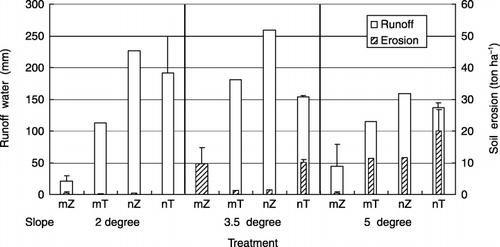
Figure 7 Example of water balance development at rain events. (a) Light rain event in the mucuna fallow plot at 5° slope from 18–21 May. (b) Heavy rain event for the tillage treatment after the natural fallow (nT) at 5° slope from 7–11 June. P, rainfall; R, runoff; D, deep percolation; ΔS, change in the amount of water stored to a depth of 90 cm.
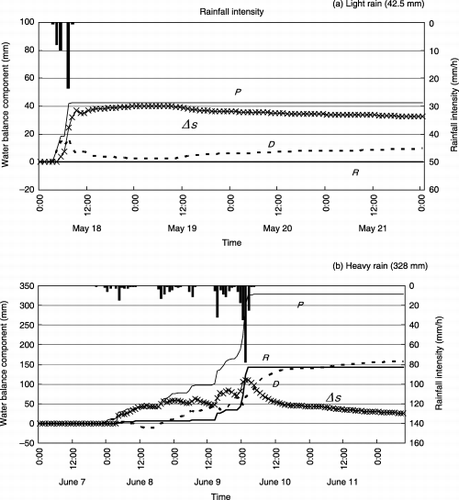
Effects of zero tillage on soil erosion and water runoff during the sorghum cropping period
During the sorghum cropping period, soil tillage treatment was imposed. The net increase in soil loss for the mT-1/2F shows clearly the adverse effect of tillage compared to that for the mZ-0F and the mZ-1/2F (,). Soil surface disturbance and exposure to rain by tillage probably increased its susceptibility to erosion, resulting in higher water runoff and soil erosion rates, although the saturated hydraulic conductivity was high (). However, a comparison of soil erosion and water runoff between the nT and the mT indicates residual effects of the previous mucuna fallow on both phenomena. The total dry biomass of the mucuna fallow was 4.4 ton ha−1, while that of the natural fallow was 1.5 ton ha−1. Incorporation of mucuna plants into the soil may have contributed to an improved soil structure and higher infiltrability. In addition, mucuna root elongation into the subsoil during the fallow period may have also contributed to rapid water infiltration into the subsoil, thus reducing water runoff and soil loss. An absence of soil surface disturbance in the nZ treatment probably contributed to a decrease in soil loss compared to nT (,). However, the nZ was not very effective when compared to the mZ. Zero tillage farming alone is even less effective from the viewpoint of water runoff. Soil crust formed during the natural fallow period probably induced the higher water runoff rate. In conclusion, zero tillage farming combined with the mucuna fallow is the most efficient among the studied treatments in terms of soil erosion and water runoff control.
Effects of different cropping systems on water balance
The descending order of runoff rate was nT-1F > mT-1/2F > mZ-1/2, whereas the deep percolation rate showed the reverse order. This suggests that prevention of water runoff induced a high rate of deep percolation. Under these conditions, nutrient loss through leaching may be important if chemical fertilizer inputs are high. Considering both water runoff and deep percolation, the total unproductive water loss may reach 75–90% of the rainfall amount. Rainfall intensities on Ishigaki Island are often very high (CitationBanzai 2001). In addition, the total rainfall amount during the cropping period was abundant for the studied year. These particular climatic conditions may have induced important water loss in all treatments. This is not the case in drier areas, such as the semi-arid regions of West Africa, where deep percolation is generally limited and where a decrease in runoff contributes to an increase in soil water storage (CitationZougmoréet al. 2004). Under such conditions, it is expected that the effects of zero tillage farming combined with a mucuna cover crop on water runoff control may be more pronounced in terms of the improvement in soil water storage. Further research is needed under conditions of lower rainfall to elucidate this subject.
ACKNOWLEDGMENTS
The authors wish to thank Dr K. Ozawa, Head of the Island Environment Management Laboratory (JIRCAS–Okinawa) for providing comprehensive support. Our thanks also go to the field and laboratory staff, Mr K. Yamato, Mr H. Ikema, Mr Y. Shikina and Mrs M. Shimabukuro. Finally, we acknowledge Dr R. Zougmoré, our fellow researcher from Burkina Faso, for corrections and advice on earlier versions of the manuscript.
Notes
Present address: Soil Research Institute, Academy Post Office, Kwadaso-Kumasi Ghana
REFERENCES
- Derpsch , R . 1998 . “ Historical review of no-tillage cultivation of crops ” . In No-tillage Cultivation of Soybean and Future Research Needs in South America , JIRCAS Working Report No. 13 Edited by: Kikuyu , M . 1 – 18 . Tsukuba : Japan International Agricultural Sciences .
- Food and Agriculture Organization . 2001 . Conservation Agriculture: Case Studies in Latin America and Africa , FAO Soils Bulletin No. 78 Rome : FAO .
- Gazziero , DLP . 1998 . “ Control of weeds in no-tillage cultivation ” . In No-tillage Cultivation of Soybean and Future Research Needs in South America , JIRCAS Working Report No. 13 Edited by: Kikuyu , M . 43 – 52 . Tsukuba : Japan International Agricultural Sciences .
- Kyuma , K , ed. 2001 . Tropical Soil Science , Nagoya : Nagoya University Press . (in Japanese)
- Cavigelli , MA and Tien , J . 2003 . Phosphorus biodiversity following incorporation of green manure crops . Soil SciSocAmJ , 67 : 1186 – 1194 .
- Griffin , T , Liebman , M and Jemison , JJ . 2000 . Cover crops for sweet corn production in a short-season environment . AgronJ , 92 : 144 – 151 .
- Martens , JRT , Hoeppner , JW and Entz , MH . 2001 . Legume cover crops with winter cereals in Southern Manitoba: establishment, productivity, and microclimate effects . AgronJ , 93 : 1086 – 1096 .
- Whitbread , AM , Jiri , O and Maasdorp , B . 2004 . The effect of managing improved fallows of Mucuna prurienson maize production and soil carbon and nitrogen dymamics in sub-humid Zimbabwe . NutrCyclAgroecosyst , 69 : 51 – 71 .
- National Institute of Agro-Environmental Science . 1996 . Classification of Cultivated Soils in Japan , Tsukuba : National Institute of Agro-Environmental Science .
- Hamazaki , T . 2005 . Soil classification system in the world and application to agricultural and forestry: 5. Classification of cultivated soils in Japan, Third approximation: Outline and characteristics . JpnJSoil SciPlant Nutr , 76 ( 3 ) : 345 – 351 . (in Japanese with English summary)
- Miyara , S , Shimo , M , Gibo , S and Onaga , K . 1999 . About crust formation on the surface of Kunigami-mahji soil . SciBullFacAgricUnivRyukyus , 46 : 109 – 112 . (in Japanese with English summary)
- Hasegawa , S . 1999 . “ Investigation method of percolation water (water balance method) ” . In Monitoring Manual of Agricultural Environments for Water Environment Conservation , Edited by: Fujii , K , Iwama , H , Imai , H and Takahashi , Y . Vol. 4 , 1 – 3 . Tsukuba : National Institute for Agro-Environmental Sciences . (in Japanese)(1)
- Lal , R . 1994 . Soil Erosion Research Methods , 2nd edn , Delray Beach, Florida : St. Lucie Press .
- Morgan , RPC . 1995 . Soil Erosion and Conservation , 2nd edn , Essex : Longman .
- Salako , FK and Tian , G . 2003 . Soil water depletion under various leguminous cover crops in the derived savanna of West Africa . AgricEcosystEnviron , 100 : 173 – 180 .
- Banzai , K . 2001 . Strong rainfalls flow away subtropical soils: characteristics of rain energy in the subtropical region and its application and measures . AgricHort , 76 ( 12 ) : 1277 – 1282 . (in Japanese)
- Zougmoré , R , Mando , A and Stroosnijder , L . 2004 . Effect of soil and water conservation and nutrient management on the soil–plant water balance in semi arid Burkina Faso . AgricWater Manage , 65 : 103 – 120 .
- Present address: Soil Research Institute, Academy Post Office, Kwadaso-Kumasi Ghana
